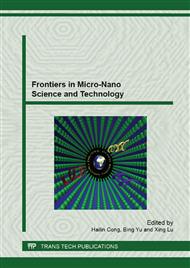[1]
Cowan S R, Banerji N, Leong W L, Heeger A J. Charge Formation, Recombination, and Sweep-Out Dynamics in Organic Solar Cells. Adv Funct Mater, 2012, 22(6): 1116 -1128.
DOI: 10.1002/adfm.201101632
Google Scholar
[2]
He Z C, Zhong C M, Su S J, Xu M, Wu H B, Cao Y. Enhanced power-conversion efficiency in polymer solar cells using an inverted device structure. Nat Photon, 2012, 6(9) : 591-595.
DOI: 10.1038/nphoton.2012.190
Google Scholar
[3]
Peet J, Heeger A J, Bazan G. C. Plastic, Solar Cells: Self-Assembly of Bulk Heterojunction Nanomaterials by Spontaneous Phase Separation. Accounts of Chemical Research, 2009, 42 (11): 1700-1708.
DOI: 10.1021/ar900065j
Google Scholar
[4]
Yu H Z, Peng J B. Performance and lifetime improvement of polymer/fullerene blend photovoltaic cells with a C60 interlayer. Org Electron, 2008, 9 (6): 1022-1025.
DOI: 10.1016/j.orgel.2008.07.010
Google Scholar
[5]
Liang Y, Xu Z, Xia J, Tsai S, Wu Y, Li G., Ray C, Yu L. For the Bright Future-Bulk Heterojunction Polymer Solar Cells with Power Conversion Efficiency of 7. 4%. Adv Mater, 2010, 22 (20): E135-E138.
DOI: 10.1002/adma.200903528
Google Scholar
[6]
You J B, Li X H, Xie F X, Sha W, Kwong J H W, Li G, Choy W C H, Yang Y. Surface Plasmon and Scattering-Enhanced Low-Bandgap Polymer Solar Cell by a Metal Grating Back Electrode. Adv Energy Mater, 2012, 2(10): 1203-1207.
DOI: 10.1002/aenm.201200108
Google Scholar
[7]
Service R F, Outlook Brightens for Plastic Solar Cells. Science, 2011, 332(6027), 293-293.
DOI: 10.1126/science.332.6027.293
Google Scholar
[8]
You J B, Chen C C, Dou L T, Murase S, Duan H S, Hawks S A, Xu T, Son H J, Yu L P, Li G., Yang Y. Metal Oxide Nanoparticles as an Electron-Transport Layer in High-Perfo -rmance and Stable Inverted Polymer Solar Cells. Adv Mater, 2012, 24(38): 5267-5272.
DOI: 10.1002/adma.201201958
Google Scholar
[9]
Shrotriya V, Ouyang J, Tseng R J, Li G, Yang Y, Chem. Phys. Lett. 2005, 411 (1-3) 138-143.
Google Scholar
[10]
Grossiord N, Kroon J M, Andriessen R, Blom P W M. Degradation mechanisms in organic photovoltaic devices. Org Electron. 2012, 13(3): 432-456.
DOI: 10.1016/j.orgel.2011.11.027
Google Scholar
[11]
Hintz H, Egelhaaf H J, Luer L, Hauch J A, Peisert H, ChasséT. Photodegradation of P3HT-A Systematic Study of Environmental Factors. Chemistry of Materials 2011, 23 (2): 145-154.
DOI: 10.1021/cm102373k
Google Scholar
[12]
Manceau M, Bundgaard E, Carlé J E, Hagemann O, Helgesen M, Sandergaard R, Jorgensen M, Krebs F C. Photochemical stability of pi-conjugated polymers for polymer solar cells: a rule of thumb. J Mater Chem, 2011, 21 (12): 4132-4141.
DOI: 10.1039/c0jm03105d
Google Scholar
[13]
Rivaton A, Chambon S, Manceau M, Gardette J L, Lemaître N, Guillerez S. Light -induced degradation of the active layer of polymer-based solar cells. Polym Degrad Stab, 2010, 95 (3): 278-284.
DOI: 10.1016/j.polymdegradstab.2009.11.021
Google Scholar
[14]
Peters C H, Sachs-Quintana I T, Mateker W R, Heumueller T, Rivnay J, Noriega R, Beiley Z M, Hoke E T, Salleo A, McGehee M D, The Mechanism of Burn-in Loss in a High Efficiency Polymer Solar Cell. Adv Mater, 2012, 24 (5): 663-675.
DOI: 10.1002/adma.201103010
Google Scholar
[15]
Hintz H, Egelhaaf H J, Peisert H, Chasse T, Photo-oxidation and ozonization of poly(3-hexylthiophene) thin films as studied by UV/VIS and photoelectron spectroscopy. Polymer Degradation and Stability, 2010, 95(5): 818-825.
DOI: 10.1016/j.polymdegradstab.2010.02.004
Google Scholar
[16]
Hintz H, Sessler C, Peisert H, Egelhaaf H J, Chasse T, Wavelength-Dependent Pathways of Poly-3-hexylthiophene Photo-Oxidation. Chem Mater, 2012, 24(14): 2739-2743.
DOI: 10.1021/cm3008864
Google Scholar
[17]
Schafferhans J, Baumann A, Deibel C, Dyakonov V. Trap distribution and the impact of oxygen-induced traps on the charge transport in poly(3-hexylthiophene). Appl Phys Lett, 2008, 93 (9): 093303-093309.
DOI: 10.1063/1.2978237
Google Scholar
[18]
Zhokhavets U, Erb T, Hoppe H, Gobsch G., Sariciftci N S. Effect of annealing of poly(3-hexylthiophene)/fullerene bulk heterojunction composites on structural and optical properties. Thin Solid Films, 2006, 496 (2): 679-681.
DOI: 10.1016/j.tsf.2005.09.093
Google Scholar
[19]
Deschler F, De Sio A, Hauff E V, Kutka P, Sauermann T, Egelhaaf H J, Hauch J, Da Como E. The Effect of Ageing on Exciton Dynamics, Charge Separation, and Recombination in P3HT/PCBM Photovoltaic Blends. Adv Funct Mater, 2012, 22 (7): 1461-1469.
DOI: 10.1002/adfm.201101923
Google Scholar
[20]
Seemann A, Sauermann T, Lungenschmied C, Armbruster O, Bauer S, Egelhaaf H J, Hauch J, Reversible and irreversible degradation of organic solar cell performance by oxygen. Solar Energy, 2011, 85 (6): 1238-1249.
DOI: 10.1016/j.solener.2010.09.007
Google Scholar



